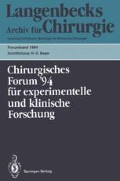Zusammenfassung
Die limitierte Lebensdauer venöser Bypässe führte zur Einführung arteriellen Graftmaterials in die Herzchirurgie. Auch hier stellt sich dem Chirurgen jedoch das Problem der begrenzten Verfügbarkeit dieser autologen arteriellen Grafts. Die weitergehende intensive Suche nach alternativen Therapiekonzepten konzentrierte sich neben der Entwicklung von Allo- und Xenografts auch auf die ”natürliche” Angiogenese im menschlichen Organismus. Wachstumsfaktoren, wie der Heparin-bindende-Wachstumsfaktor HBGF-I, wirken über ein hochaffines Rezeptorsystem, das auf der Zelloberfläche lokalisiert ist und eine signifikante Steigerung der zellulären Proliferation, Migration und Differenzierung herbeiführt.
Access this chapter
Tax calculation will be finalised at checkout
Purchases are for personal use only
Preview
Unable to display preview. Download preview PDF.
Literatur
Schumacher B, Schlaudraff K, Scitelberger R, v. Specht B-U, Fasol R: Growth of ‘new’coronary vascular structures by angiogenetic growth factors. Eur J Cardio-thorac Surg 1993; submitted
Gospodarowicz D, Cheng J, Kui GM, et al. (1984) Isolation of brain fibroblast growth factor by heparin-sepharose affinity chromatography: identity with pituitary fibroblast growth factor. Proc Natl Acad Sci USA 81:6963–6967
Morgan DML (1987) Oxidised polyamines and the growth of human vascular endothelial cells. Prevention of cytotoxic effects by selective acetylation. Biochem J 242:347–352
Friesel R, Burgess WH, Mehrman T, Maciag T (1986) The characterization of the receptor for endothelial cell growth factor by covalent ligand attachment. J Biol Chem 261:7581–7584
Author information
Authors and Affiliations
Editor information
Editors and Affiliations
Rights and permissions
Copyright information
© 1994 Springer-Verlag Berlin Heidelberg
About this paper
Cite this paper
Schlaudraff, KU., von Specht, BU., Kolvenbach, H., Stegmann, T., Schumacher, B. (1994). Induktion neuer funktioneller Blutgefäße beim Menschen durch den ersten klinischen Einsatz des humanen Wachstumsfaktors HBGF-I. In: Beger, H.G. (eds) Chirurgisches Forum ’94. Langenbecks Archiv für Chirurgie, vol 94. Springer, Berlin, Heidelberg. https://doi.org/10.1007/978-3-642-78905-2_35
Download citation
DOI: https://doi.org/10.1007/978-3-642-78905-2_35
Publisher Name: Springer, Berlin, Heidelberg
Print ISBN: 978-3-540-57846-8
Online ISBN: 978-3-642-78905-2
eBook Packages: Springer Book Archive

